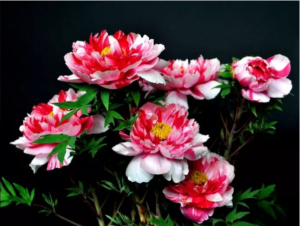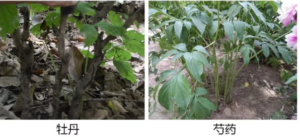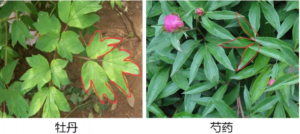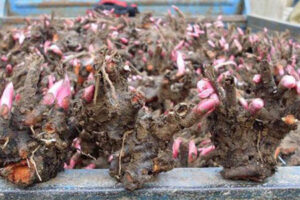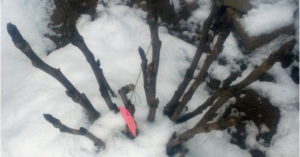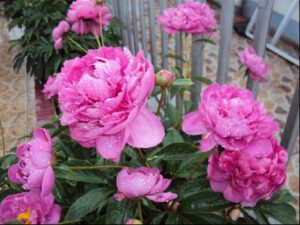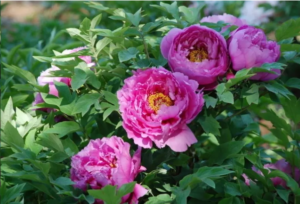In the growing process of tree peony and Paeonia lactiflora pall, insect damage will inevitably occur. The peony seedlings with diseases and insect pests often have leaves covered with disease spots or withered edges, branches are thin and weak, roots rot and become incomplete, and in serious cases, they even bloom or not, plant Growth and development slow, but also affect the quality and yield of Root Bark, if not timely control, will also affect other flowers. Therefore, in the cultivation and management of tree peony and Paeonia Lactiflora, it is necessary to know the occurrence regularity and control measures of their common diseases and insect
pests.
1. Gray mold
The disease has a short onset and is spread by wind, causing great harm.
(1) the symptom seedlings appeared Brown watermarked spots at the base, and the seedlings gradually withered and fell down. Infected Leaves Produce Brown, purple-brown water spots, sometimes with irregular whorls, to the tip and leaf margin more. The gray mould layer in the diseased part is a prominent feature of the disease. Botrytis cinerea is a fungal disease.
(2) conditions of onset
The persistent low temperature and humid climate are the main causes of the disease. Spring and the end of flowering period from June to July were the peak period of the disease. Plant clusters are large and dense, and too much nitrogen fertilizer is also susceptible to disease.
(3) prevention and control
Find and remove the diseased parts in time, pull out the diseased plants and destroy them in time, take care not to contaminate the healthy plants, and disinfect the tools that come into contact with the diseased plants in time.
2 In case of disease, chemical control can be carried out: 1% equivalent bordeaux mixture, 70% thiophanate-methyl 1000-fold solution, 65% ZNZ 500-fold solution or 50% ammonium chloride 1000-fold solution are sprayed once every 10-15 days and continuously 2-3 times.
3 strengthen cultivation management, arrange planting density reasonably, remove water in time after rain, and loosen soil to hoe. The newly purchased tree peony seedlings were soaked for 10 ~ 15 minutes in 65% 300-fold solution of daisenxin before continuous cropping was carried out in the serious disease area.
In autumn, the dead branches and leaves were removed, and the diseased buds and leaves were removed in time to reduce the source of infection.
Leaf spot disease
A. Erythema
Red Spot disease also known as leaf spot disease, peony disease less, mainly to harm the peony.
(1) pathogen cladosporium peony: Fungal Diseases.
(2) symptoms
Damage to the leaves, planting strip, flower, seed and other parts. The lesions appeared initially on the upper and lower surfaces of the leaves, Brown, Submycorrhizal, the edge of the lesions was not obvious, when severe, the leaves twisted, dry. Wet and rainy weather can be seen gray-green mold layer, stem and petiole spot long strip, Central Crack, disease department easy to break. When the disease spot on the flower organ is serious, the edge of the petal will be scorched.
(3) conditions of onset
In warm and rainy climate, the diseases will be caused or aggravated by the application of too much nitrogen fertilizer, the planting density is too high, which leads to poor ventilation or the retention of diseased plants. Peak season in spring and summer.
(4) prevention and control
1 clear the disease strain in time, spray 50% CARBENDAZIM 600 times solution or 3 Be sulfur mixture before germination in early spring to kill the plant and above-ground bacteria.
2 when peonies germinated in early spring, spreading thin film on the ground and pressing the edges with Earth pressure can prevent the spread of pathogens and accelerate the decomposition of disease residues.
3 after onset, 160-200 times equivalent Bordeaux mixture can be sprayed once every 10-15 days, or 50% carbendazim 1000 times, 65% thymosin 500-600 times, once every 7-10 days for 3-4 days.
4 strengthen the management of peony seedling cultivation, arrange planting density reasonably, apply nitrogen fertilizer properly, apply compound fertilizer and organic fertilizer more.
5 reduce the source of infection: Spray 3 Be sulfur mixture or 50% CARBENDAZIM 600 times solution in early spring. Autumn thoroughly remove the body of disease and disability.
Alternaria leaf spot
Also known as White Star disease, is a common tree peony disease.
(1) pathogens
1. CERCOSPORA PEONIAE 2
(2) symptoms
The blades are the hardest hit. At the beginning of the leaves appear Pale yellow spots, gradually expanding into a round or nearly round spot, Brown, and visible whorls, scattered above a lot of small points of mold, to the central spot most dense. The lesions near the leaf margin and main vein were semicircular in shape. The whole leaf is scorched when the disease is serious.
(3) conditions of onset
Rainy and humid climate, low-lying and water-accumulating terrain, poor ventilation and light transmission, and high planting density are all suitable to cause the disease, which is the main leaf disease in the late growth period of peony. August to September is the peak period.
(4) prevention and control
1 Chemical Control in growing season: 1% lime equivalent bordeaux mixture, 50% triazolam 800-fold solution or 65% thymosin 500-fold solution were sprayed once in 10-15 days after onset and continuously for 1-2 months.
2 strengthen cultivation management, arrange planting density reasonably, and pay attention to ventilation and light transmission.
3 Prevention of disease and reduction of infection source: Spray 3 Be sulfur mixture or 50% CARBENDAZIM 600 times solution in early spring. Autumn thoroughly remove the body of disease and disability.
C. Ring Spot
Also known as leaf gray spot, peony, peony are harmful, but not as common as the first two, is a fungal disease.
(2) symptoms
A large round or nearly round spot may be formed on the leaf, the diameter of which may be more than 5 mm. There are obvious concentric rings, which are Grayish Brown, and many small black mould spots in the middle are arranged in a wheel shape.
(3) the conditions of disease and its prevention and control
Alternaria leaf spot of tree peony.
Anthracnose of peony
(1) pathogens
A type of anthrax: Fungi IMPERFECTI.
(2) symptoms
Leaf Blade, petiole and neck. After anthesis, a small brown spot appeared on the leaf surface, and gradually expanded, and was hemimycete-shaped, black-brown by the inhibition of leaf veins, to the late middle of the spot into white, Edge red-brown, and split, perforation, spot scattered on a lot of black spots, under moist conditions, the reddish-brown myxomycetes can be seen on the stems and petioles. The infected stems are often twisted, and if the tender stems become diseased, they will soon die. Bud Scales and petal damage often cause bud blight and flower deformity.
(3) conditions of onset
High temperature, rainy, dew, planting density is too large easy to cause the disease.
(4) prevention and control
1 CHEMICAL CONTROL IN GROWING SEASON: spraying 70% thiram 500 times solution, or 1% lime equivalent bordeaux solution, 65% THYSSEN ZINC 500 times solution, once every 10-15 days for 1-2 months.
2 Prevention of disease and reduction of infection source: Spray 3 Be sulfur mixture or 50% CARBENDAZIM 600 times solution in early spring. Autumn thoroughly remove the body of disease and disability.
Root Rot
(1) pathogens
It was mainly fusarium Solani, other fusarium species and Armillaria compound infection.
(2) symptoms
The symptoms of peony and Paeonia lactiflora in spring appear after leaf expansion. The growth of the above-ground part is weak, the leaves are green, yellow and red, and the branches and leaves die when it is serious, if not controlled in time, the whole plant will die. When digging out the diseased plants, the roots were usually black-brown and some of them decayed, and there were traces of Grub gnawing.
(3) conditions of onset
Field seeper and wet environment more disease, continuous cropping land is often a large number of disease. When the pest is serious underground, the wound on the root also makes the germ easy to infect. Tree Peony seedlings planting, with soil lump transplant is also prone to disease.
(4) prevention and control
1 to strengthen the control of GRUBS, Furadan or methyl-isulphos 3ー5 kg per mu were applied before the soil was turned over in autumn, when the GRUBS were turned over into the soil, the same medicament 3ー5 G was applied in the planting holes, the emergence of adult insects and the emergence of adult insects should be paid attention to the control of adult insects.
2 Peony seedlings were planted in the sun, then the bare roots were soaked in 600 ~ 800 times of wettable thiophanate-methyl and 1000 times of the mixture of isosalifon-methyl for 2 ~ 3 minutes before planting.
Downy leaf blight of tree peony
Commonly known as "Black Knot head disease" , is one of the more serious peony diseases, is a root disease.
(1) Pathogenic Basidiomycete Mulberry
(2) symptoms
When the onset, near the ground roots and roots covered with cotton-like purple or White Mycelium, the initial site of the victim was yellow-brown, later turned black. Old Roots Rot, no new roots, the above-ground branches thin, late germination, leaves become small, and finally from the top down dry and die.
(3) conditions of onset
It happens all the time, all the time. The rainy season in early summer is the peak period of the disease. The disease can also be caused by newly reclaimed land and low-lying wet land, or by improper application of raw and heavy fertilizers.
(4) prevention and control
13 ~ 4 years rotation, pay attention to choose loose soil, good drainage of dry terrain, apply fully decomposed farm manure, avoid direct foundation root fertilizer.
2 pull out the infected plant in time, also can scrape the rotten part with a knife and then use 4 ~ 5 Be mixture of stone sulfur or 1% copper sulfate to disinfect and plant, and disinfect the soil around the infected plant with lime or sulphur.
3 when peony seedlings were propagated by dividing plant in autumn, the roots were soaked in 1% copper sulfate for 3 H or 0.5 H in lime water. Rinse with water and plant.
4 at the beginning of the disease, the roots were watered with 5% ZINCON 1000 times liquid, 500ー1000 ml per plant, and then covered with soil










